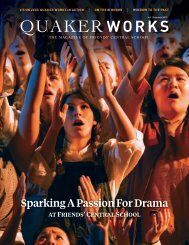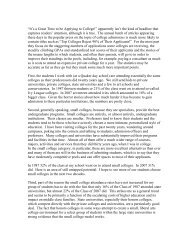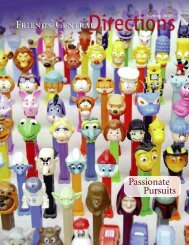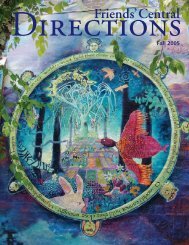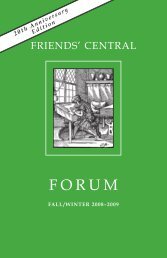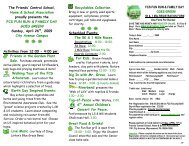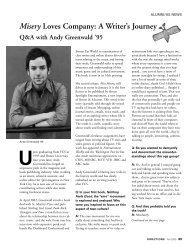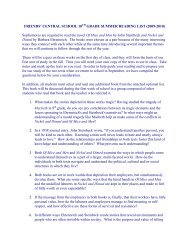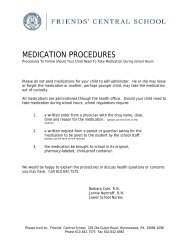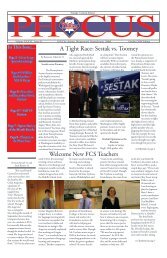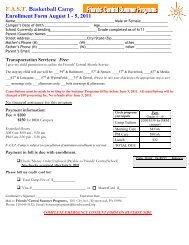2006-2007 Fall/Winter Directions - Friends' Central School
2006-2007 Fall/Winter Directions - Friends' Central School
2006-2007 Fall/Winter Directions - Friends' Central School
You also want an ePaper? Increase the reach of your titles
YUMPU automatically turns print PDFs into web optimized ePapers that Google loves.
CAMPUS LOG – LOWER SCHOOL<br />
The Enchanted Friendship Tree<br />
they took turns serving various tropical fruits. They learned a<br />
song to help them remember the layers in a rainforest, and they<br />
filled their room with vines and hanging monkeys. Next door,<br />
the pre-kindergarten children in Kristi Kallam’s and READ<br />
DeSabato’s class studed Winnie the Pooh. They built Pooh’s tree<br />
house, had a tea party to celebrate Pooh’s 100th birthday, and<br />
made balloon sand bees to toss around with their project<br />
buddies in third grade.<br />
Second graders went to Pennsylvania Hospital to learn about<br />
medicinal herbs; other classes visited the Morris Arboretum and<br />
the Arboretum on the Upper <strong>School</strong> campus; there were plays<br />
and performances; and all of the classrooms sent each other<br />
“leaf notes”—messages written on leaf-shaped paper and secretly<br />
delivered baskets outside each classroom. These notes are just<br />
one example of how the <strong>Fall</strong> Project encourages the children to<br />
connect with each other across grades and classrooms.<br />
The <strong>Fall</strong> Projects began in the mid-1970s when the faculty<br />
set out to enliven the months they spent reviewing material.<br />
They also wanted to find a way to unify the <strong>School</strong> and generate<br />
opportunities for shared activities. In 1977 the program<br />
caught fire when the faculty designed TERRA, an imaginary<br />
planet, and each classroom became a different nation, with its<br />
own language, literature, and culture. Since then the themes<br />
have included such diverse topics as Flight, Islands, Latin<br />
America, and Literary Places.<br />
Assistant Principal Lou DelSoldo explains that for children<br />
this young, “the thematic course of study is particularly valuable<br />
because the limited focus it provides helps them build the cognitive<br />
structure and skills they need to retain a wider range of<br />
information.” It also teaches them to look for connections<br />
across disciplines and helps develop their sense of belonging to<br />
a larger community of learning. Teachers enjoy collaborating on<br />
20 DIRECTIONS <strong>Fall</strong> <strong>2006</strong> / <strong>Winter</strong> <strong>2007</strong><br />
lesson plans and all-school assemblies, while students consciously<br />
follow what is happening across the hall or upstairs.<br />
At the end of each fall, the entire Lower <strong>School</strong> gathers for a<br />
culminating event that features everyone’s special focus. This year<br />
they created a giant, “enchanted friendship tree.” Each classroom<br />
made something to represent their studies and fill the branches—<br />
butterflies, bees, hobbits, acorn dolls, red ants, characters from<br />
Robin Hood. The tree covers one whole wall in the meeting<br />
room and will stand all year as a colorful, vibrant testament to<br />
the enduring power of the <strong>Fall</strong> Projects. More than anything else,<br />
the children at Friends’ <strong>Central</strong>’s Lower <strong>School</strong> are learning that<br />
school can stimulate their imaginations, test their creativity, and<br />
form the basis for a community of friends.<br />
Lower <strong>School</strong> faculty play



